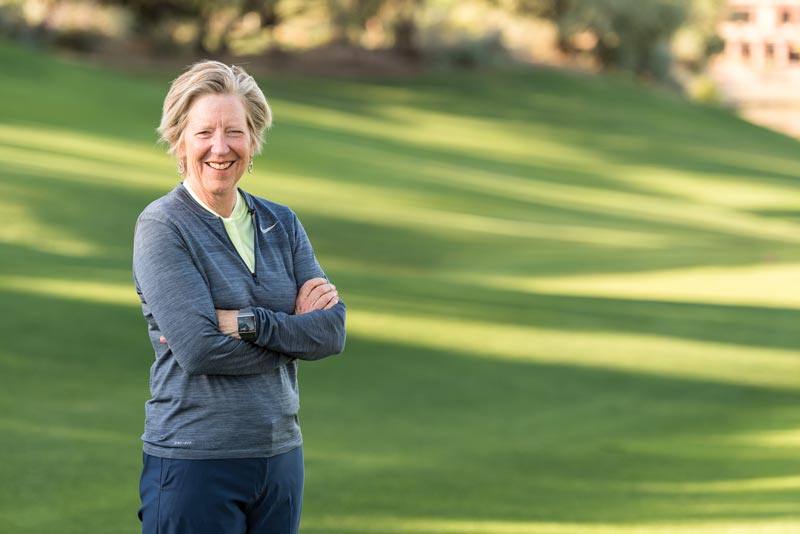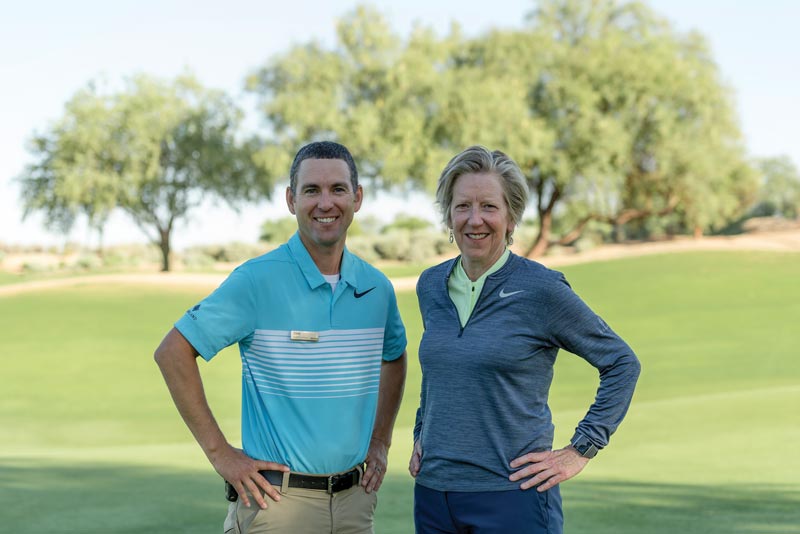
Nancy Dickens has risen through the ranks of the golf course management industry to her current position as director of golf at The Westin Kierland Resort & Spa in Scottsdale, Ariz. Photos by Traci Edwards
“This is a man’s world,” shouts James Brown in that popular song from the 1960s, echoing a sentiment that has cast a shadow over the golf course management profession for many decades.
But don’t try to sell that notion to Nancy Dickens, CGCS. Thanks to her diligence, dedication and a true knack for innovation, Dickens has ascended from a $5-an-hour, part-time agronomist at Pinehurst No. 2 in 1992 to The Westin Kierland Resort & Spa in Scottsdale, Ariz., where she has worked as director of agronomy and now helms the club as its director of golf.
Dickens is one of only 30 women among 5,340 Class A GCSAA members — and one of only 10 to hold the CGCS designation — but she insists that isn’t because the opportunity isn’t there for women, or that women are being held back.
“There just aren’t as many women in the agronomy field as perhaps other areas of the golf industry,” the 24-year GCSAA member says, “though, like any field, there are great opportunities for young women in the agronomy side of the business.”
Growing up in St. Joseph, Mo., Dickens had an athletic mother who taught her golf and tennis, “because Mom knew those were lifetime games I could always enjoy.” Dickens enjoyed golf but took more to tennis early on. She was talented enough to earn a scholarship to play for Baylor University in Waco, Texas, where she earned her bachelor’s degree in business and had hopes of one day owning and operating her own tennis and racket club.
After graduation, Dickens landed a job at Hallmark Cards in Kansas City, Mo., one of Missouri’s largest employers. Though she says she enjoyed her time there, she became intrigued by the idea of having a career outdoors. This was where her golf roots came in handy, as the brother of Dickens’ supervisor at Hallmark was the assistant golf course superintendent at Kansas City Country Club at the time.
“I thought, ‘Wow, what a cool job he has, being outside and being involved in both sports and in business,’” she recalls. “I discovered that being a golf course superintendent is like running a small business with multiple employees and a budget to manage. That interested me a great deal.”
The climb begins
In fact, an agronomy career interested Dickens so much that she left her job at Hallmark, packed her car and headed to Pinehurst, N.C., one month prior to Pinehurst No. 2 playing host to the Tour Championship, for that part-time, $5-an-hour position working at the storied facility, just three days a week, Fridays through Sundays. The rest of the week, she commuted to Raleigh-Durham to work on earning her associate of applied science degree in turfgrass management from North Carolina State. She graduated two years later, in 1994.
“I was surprised that out of about 80 students in that program, very few were women, and most of those were studying horticulture,” Dickens says.
After doing a brief internship in Florida and earning her turf degree, Dickens was lured all the way across the country for a job at Mission Hills Country Club in Rancho Mirage, Calif. Dickens was familiar with the facility, having interned there while working at Pinehurst No. 2.
“Pinehurst coordinated my internship at Mission Hills because they were both ClubCorp courses,” she says. “At the end of my internship, Mission Hills offered me the assistant superintendent position, at which time I returned to N.C. State to finish my final semester in the fall. Then, I headed west in January 1995 to begin my career there.”
Just one year after joining Mission Hills, she was promoted to head superintendent for both the Arnold Palmer and the Dinah Shore Tournament courses. “It was an incredible experience that taught me a lot about the business. I reported to the director of agronomy, and under that leadership, I felt quite eager to eventually have my own course,” she says.
That opportunity came one year later, when she accepted the job as head superintendent at the Sun City Mountain Vista Golf Club, designed by Billy Casper and Greg Nash, which was being built at that time in Palm Desert. It was an experience Dickens cherished.
“The course was still under construction when I arrived, so it allowed me the opportunity to learn a great deal about golf course construction that I may not have otherwise had access to learning along the way,” she says.

Kierland Resort features 700 guest rooms, 27 holes of golf and a full-service spa among its many amenities.
Dickens stayed on at Sun City for five years before being asked in 2002 to join Troon Golf as director of agronomy in Rancho Mirage at The Westin Mission Hills Resort, overseeing both its Pete Dye and Gary Player courses.
“Joining Troon was an incredible opportunity for me, working for such a highly regarded management company,” Dickens says. “I was certain there would be an abundance of opportunities within Troon, as long as I remained true to my dedication toward doing the very best job possible, and I was right.”
Kierland Resort: A world-class opportunity
Evidently, Dickens did a great job at The Westin Mission Hills Resort, because in January 2005, she was asked to take over as director of agronomy at Scottsdale’s Kierland Resort, another Troon-managed facility. “It was a great opportunity at a world-class resort, and it offered a chance for me to utilize all of the knowledge I had gained along my journey to that point,” she says.
The job would also be a challenge, with three nine-hole golf courses, all designed by Scott Miller, a former designer for Jack Nicklaus. This desert oasis resort’s reputation and livelihood historically relied a great deal on the conditioning of those courses.
Dickens was up to the challenge, and the resort has thrived under her watch. And thanks in large part to that consistently excellent conditioning, a reputation spread to potential guests who learned they could count on a great golf experience for their vacations and meetings, no matter how they hit the ball.
With more than 700 rooms, the Kierland Resort is family-oriented and features amenities such as a water park, a full-service spa and an assortment of award-winning kids’ programs. But it is the facility’s renowned golf program that remains the centerpiece of the resort. “We have a fabulous spa and wonderful amenities,” Dickens says. “But our courses garner a good deal of the attention, whether with families, buddy trips or business meetings.”
Innovation encouraged
Dickens had been the director of agronomy for eight years when she was offered and accepted the job of the resort’s director of golf in 2013. It’s a fairly rare kind of leap — to go straight from agronomy to directing the entire golf program at a big resort, without a transition, without passing “Go.”
What helped qualify Dickens for that leap was her completion of Troon’s LEADer program (Leadership, Education and Development), which grooms Troon employees to be future general managers. Those invited to go through the program must be nominated and must have been with Troon at least one year. They must also show strong performance, have flexibility in their career goals, be willing and able to relocate, and be role models in Troon’s leadership culture. That was Nancy Dickens.
“With my agronomy background and my business degree, this was a great training program for me,” she notes.
And it paid off. As Kierland Resort’s director of golf, Dickens has a load of responsibilities and wears a lot of figurative hats. She is responsible for the overall strategy and direction of the club, and supports the entire golf course team and facility. She is also in charge of revenue management; sales and marketing; the overall guidance of the turf team; and the staff’s training and management.

Dickens entrusts the day-to-day agronomic care of the golf courses at Kierland Resort to superintendent Dan Figueras.
“In my job, every day is a new experience and a different one. But the one constant is that the expectations here are always high, and as such, our team aims to make sure every guest leaves feeling they have had their best golf experience to date,” Dickens says.
Meeting those lofty expectations is made somewhat easier by the fact that Kierland Resort, by design, “is a fun place,” Dickens says. “We are not afraid to try new and different things in the hopes of creating an experience that is, above all, fun, memorable and unlike anything guests have experienced previously.”
For example, Kierland Resort years ago experimented with air-conditioned golf carts (air-cooled by ice through a blower) for hot desert summer play, and it now offers Segways and Turf Rider scooters as alternatives to traditional golf carts.
“We test a range of innovative programming ... to try to attract people to the game, both newcomers and seasoned golfers alike,” Dickens says, adding that such innovations are encouraged by Troon.
Keeping a course conditioned in the desert — with intense summer heat and watering restrictions — is a challenge. “We are a member of the Audubon Cooperative Sanctuary Program for Golf,” says Dickens. “We strive to be a good steward of the environment.”
In 2013, working with course designer Miller, Dickens led her staff in a conservation project to remove 17 acres of turf in and around the courses. An additional 11 ½ acres were removed in 2017, mostly from behind the greens and around tees. The courses at Kierland Resort are not typical desert target golf courses: Hilly fairway borders funnel many errant shots back into play, which keeps lost balls to a minimum, improving pace of play and helping players — many of them vacationers with rusty golf swings from winter climates — score better on challenging courses.
Where the girls are
As golf director, Dickens finds her agronomy knowledge and experience invaluable.
“Our current golf course superintendent, Dan Figueras (a 15-year GCSAA member), was my first hire, and he’s done an amazing job,” she says. “It’s important for me to empower our team, and I never look over Dan’s shoulder, though I’m happy to lend guidance when he needs me. My agronomy background and experience as superintendent at this course can be a big help. Dan has been here five years now, and I really enjoy the exchange of ideas that we share with each other.”
As for there not being more women in the golf course management profession, Dickens says she’s surprised. She points out that various entities within the golf business are actively working to get more girls involved in junior programs, such as the Drive-Chip-and-Putt promotion that culminates at Augusta National, a program created by the Masters Tournament Foundation, USGA and PGA of America.

Environmental sustainability has always been important to Dickens. Kierland Resort is a member of the Audubon Cooperative Sanctuary Program, and a pair of conservation projects, in 2013 and 2017, removed more than 28 acres of maintained turf in and around the golf courses.
“We have lots of junior girls getting into golf now, so we just have to find a way to direct a lot of them into agronomy and let them know the opportunities are there for them,” Dickens says. “If nationally we can get more girls exposed to GCSAA, we can get more girls interested in our business. Nowadays, a little girl can do anything and be anything, and this is a fun and promising career.”
Dickens acknowledges there are challenges in attracting young people to careers in golf course management, and not just girls: “You often have to be at work at 4:30 in the mornings during the summers, and I realize that is not attractive to some people.” But Dickens also recognizes the many positives of the business — positives she has seen up close and personal throughout her career.
“I really do hope to see more women in golf course agronomy, because it’s a great, great job,” she says. “There are already a lot of women in horticulture, and the transition between that area and golf course agronomy is really quite seamless. I’m hopeful more women identify with the opportunity and seize it.
“My career has exceeded my expectations, thanks to a game my mom introduced to me when I was 6 years old,” she says. “I have loved being in the agronomy business, and a big part of my heart stays in it.”
Dan Gleason is a Phoenix-based writer whose award-winning articles have appeared in national publications. He teaches graduate-level fiction writing for Southern New Hampshire University Online.